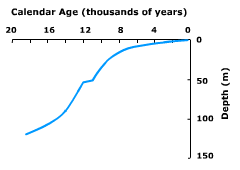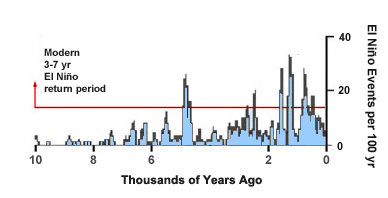Coastal Morphology Group • Scripps Institution of Oceanography
Modeling paleocoastlines

 n Coastal Basics, we explain how wave energy and sediment transport shape the modern coastline. Now we look at how sea level rise and El Niño/La Niña phases of climate transformed the southern California coast during the Holocene.
n Coastal Basics, we explain how wave energy and sediment transport shape the modern coastline. Now we look at how sea level rise and El Niño/La Niña phases of climate transformed the southern California coast during the Holocene.
Sea Level and Coastal Processes
The initial appearance of sand beaches is a crucial turning point in the recent evolution of the southern California coast. Sea level has changed dramatically during the last 20,000 years from a glacial lowstand to its present interglacial high level. Click on the sea level buttons below to view a sequence of coastline responses to sea level change.
ENSO Forcing of Wave Climate and Sediment Flux
In Climate Change/The Present, we describe how El Niño influences both wave climate and sediment flux. Southern California's coast is particularly sensitive to ENSO state. During El Niño winters, anomalously high rainfall and wave energy cause floods and coastal erosion. La Niña-type climate brings milder, drier winters particularly in the southernmost region of the coast. Wet, El Niño-dominated climate can last for several decades, followed by 20-30 years of dry, La Niña type climate. Wave climate changes dramatically between El Niño and La Niña-type winters.
Sediment yield to the coast is also strongly affected by these wet and dry climate periods. Wet periods with many El Niño winters bring twice the amount of sediment to the coast of the Santa Maria region as is supplied during the dry periods. The Santa Barbara coast receives 5 times more sediment in wet periods because of its highly erodible, mountainous terrain. And on the San Diego coast, the wet period is almost the only time that sediment is supplied to the coast.

(data from Inman and Jenkins 1999).
How did Holocene climate affect the coast?
Climate proxies tell us that El Niño events were extreme but infrequent in the period 12-8,000 years ago. A long paleoclimate record from an alpine lake in Ecuador shows a systematic change in El Niño activity during the Holocene. Between 8,000 and about 5,000 years ago, winters were dry. Starting around 5,000 years ago, El Niño floods became more frequent and the intervals about 3,000 and after 2,000 years ago were particularly stormy.

Explore the Holocene evolution of the Santa Maria, Santa Barbara, Oceanside, and Silver Strand littoral cells in the next four sections.
Coastal Morphology Group • Scripps Institution of Oceanography
©2002-2004 by the Regents of the University of California and the Kavli Institute.
All rights reserved.
Last modifed Tuesday August 30, 2005

